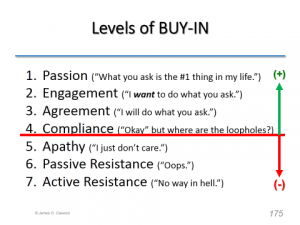

 Article
Article

 When you ask someone to do something, you could get a variety of responses. These responses, what many business managers call “buy-in,” range in analog, not binary, fashion from outright revolt to passionate acceptance — it’s a sliding scale.
When you ask someone to do something, you could get a variety of responses. These responses, what many business managers call “buy-in,” range in analog, not binary, fashion from outright revolt to passionate acceptance — it’s a sliding scale.

Insights from
When you ask someone to do something, you could get a variety of responses. These responses, what many business managers call “buy-in,” range in analog, not binary, fashion from outright revolt to passionate acceptance — it’s a sliding scale. Consider the following possibilities:

At Level 7, people might respond to your request with active resistance. This is the stuff of strikes, rebellion, revolt and active antagonism. People who fight what you want are resisting you. They may organize a union, sue you or do what they can in the marketplace to undermine you and your company.
At Level 6, people might respond with passive resistance. They don’t fight you, but they go slowly, lose the paperwork, drop a wrench in the gears or drag their feet. Passive resistors are not willing to stand up and be counted, but they are willing to slyly sabotage the works. Passive resistors are a sea anchor drag on an organization.
At Level 5, people can manifest apathy; they just don’t care what you say or do. This often comes up in organizations in which the senior leadership changes regularly but the lower levels continue on, such as large bureaucracies and civil organizations. They’ve seen leaders come and go, they know that each is trying to make his or her resume look good, and they know that “this, too, shall pass.” So, they just continue doing what they’ve been doing, ignoring the leadership. Apathetic people keep their heads down, do just what they need to to get by, and create a culture of mediocrity.
At Level 4, we get a condition that I detest, compliance. Compliance means that people say they will do what you ask and all the while they are looking for ways around the rule or request. They say “yes,” and then they look for ways to get around the rule. Compliant workers obey the letter of the law but not the spirit.
At Level 3, we have agreement, in which the person says, “I will do what you ask me to do without reservation.” They may not be energetic or enthusiastic, but they are willing to do the thing you ask.
At Level 2, we have engagement, in which people not only agree to do what you ask, but they are actively and positively disposed to do it. They have a positive value for what you ask them to do. People with engagement want to do what you ask.
At Level 1, we have passion, in which people say or think or believe that what you ask them to do is the most important thing in life and they will sacrifice evenings, weekends, exercise, relationships and vacations in order to strive to accomplish what you ask. They might even blow themselves up for what you ask.
We can think of this scale as an energy scale, with the neutral line lying between apathy and compliance. The responses above that line are levels of increasing positive energy, the responses below that line are levels of increasing negative energy. So, what a leader is really trying to do with any endeavor is create positive energy in those who are responding. Getting “buy-in” is not a binary event, it is an analog event. When you ask people to do something, pay attention to their levels of “buy-in.” Don’t assume because they say “yes” at Level 1 visible behavior that they mean it. Watch their energy levels. The observant leader will note the levels of buy-in he or she is getting from others and adjust his or her style to compensate. Leadership is about managing energy, first in yourself and then in those around you.
Reprinted with the author’s permission.
Clawson is an authority on leadership. He recently wrote books titled Level Three Leadership: Getting Below the Surface (fifth edition), Powered by Feel: How Individuals, Teams and Companies Excel (with Doug Newburg) and Balancing Your Life: Executive Lessons for Work, Family and Self. Clawson has authored more than 300 cases and technical notes.
Clawson is considered an authority in tactical and strategic leadership. He says, “leadership is about managing energy, first in yourself and then in those around you.” His expertise also spills over into fields such as managing change, career management, management development and pedagogy.
He taught at Harvard Business School, worked as a functional trainer for Mobil Oil Company in Japan and served as an international banking officer for Wells Fargo Bank before coming to Darden.
Clawson has consulted on every continent except Antarctica.
A.B., Stanford University; MBA, Brigham Young University; DBA, Harvard University